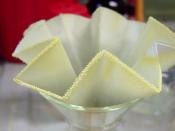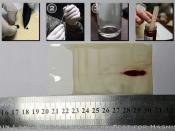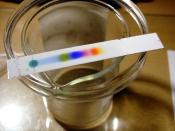Purpose:
In this lab experiment the mixtures of organic compounds are separated using liquid chromatography. TLC separation takes pace on a thin layer of solid stationary phase spread on a solid support as a liquid mobile phase, also simply called solvent, moves along the plate. In particular a Cartotenoid called Bixin is isolated from a mixture of Carotenoids found in annatto seeds in this experiment. Although this technique is often used to separate uncolored mixtures of compounds in this case colored compounds are used so that it is possible to observe the separation as it occurs.
Reagent table:
M.W(g)Molecular form
Bixin394.5096C25H30O4
Methylbixin408.236C26H32O4
Norbixin380.216C24H28O4
All E-Geranylgeraniol288.194C20H32O
Geranylgeraniol esters315.198C21H31O2
Phytoene541.4C40H64
Phytofluene542.896C40H60
Carotene536.88C40H56
Nurosprene538.864C40H58
Procedure:
Place 2.0 grams of crushed annatto seeds in a 50 mL beaker. To the beaker add a magnetic stir barr and 5 mL of 8% Ethanol in methylene chloride solution. Allow the solution to stir for 5 to 10 minutes.
Vacuum filter the solution through a course fritted filter. Transfer the dark orange filtrate to a clean 50 mL beaker. Transfer the filtered solids back into the original beaker. Repeat the extraction of the crushed annatto seed residue with 5 mL of the 8% Ethanol in methylene chloride solution two more times. Each time vacuum filter the orange solution through a course fritted funnel. Combine the annatto extracts into the same 50 mL beaker as the first extract. After completing the TLC analysis place a boiling chip in the annatto extract in the beaker and boil the solvent until only approximately 1 mL remains. Do not boil the dryness. The solution spatters and bumps if boiled to dryness. Remove the remaining solvent by passing compressed air or nitrogen over the beaker for several minutes. Set up and label5 TLC plates, one for each of the different solvents...


